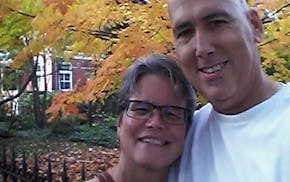What do you get when you combine a St. Louis Park fine art gallery, a gang of burglars, some Chicago wiseguys, an exotic, coke-snorting Northwest Airlines flight attendant, a part-time magician and his charismatic wife and daughter?
You get a scene from the Twin Cities, circa 1978. It doesn't exactly sound like a Norman Rockwell painting, does it?
Speaking of which, add to the plot seven stolen Rockwell paintings and a fake Renoir.
Local journalist Bruce Rubenstein knew what he had: a great story.
His book, "The Rockwell Heist," (Borealis Books) is due out this week. It tells the little-known tale of Minnesota's largest art theft, at Elayne's Gallery in St. Louis Park, and the subsequent 20-year quest to recover the art.
The paintings, valued at more than $500,000, were stolen from the now-closed Elayne's on Feb. 16, 1978. Everyone suspected some shady-looking men who appeared to case the joint the day before, but no one was ever charged in the crime.
Rubenstein, 74, has covered murder and mayhem in the state since the 1980s for publications such as Mpls/St. Paul and Minnesota Monthly magazines and City Pages.
The dogged investigative reporter, who splits his time between the Twin Cities and an off-the-grid home in the Arizona desert, has always been drawn to the dark side. His work has caused him to bump up against lawmen, bad actors and cons, in places like Spanky's and the infamous Moby Dick's.
Keeping that kind of company paid off when he got the book deal after writing part of the story for Minnesota Monthly three years ago.
To find out who did it, and how, Rubenstein interviewed perhaps a hundred people. Bonnie Lindberg, daughter of owner Elayne Lindberg, turned over thousands of pages of FBI documents to assist Rubenstein's hunt.
"I interviewed former cops, on and off the record, and former attorneys, on and off the record," said Rubenstein. "And I interviewed bad guys. Those were off the record."
There was too much research to keep at home, so Rubenstein worked from a borrowed office.
In the months after the heist, the FBI pursued the case with some vigor. They thought it looked like an inside job and had several suspects, including owner Elayne Lindberg and another man who owned the fake Renoir.
One of the plot lines was that the mob wanted to retrieve the fake Renoir, and offered burglars the Rockwells as the fee.
"The FBI didn't care about the paintings, they wanted to get inside the Miami mob and New York mob," Rubenstein said. The FBI's zeal died away before long, but Bonnie Lindberg's didn't.
Finally, a break in the case
Partly because their mother was an early suspect (which proved false), children Bonnie and Gary followed clues and odd tips for two decades before what the book's news release calls "the final dramatic resolution." (I won't spoil it).
The strange tale winds through the world of international art theft, from Miami to Europe to South America, where the Lindbergs traveled to try to buy the paintings back.
Some notable Minnesotans make cameo appearances, such as attorney Joe Friedberg, who was approached to try to negotiate a sale back to the gallery. (He declined).
Rubenstein's break came when a former prosecutor put out the word that Rubenstein needed help. He eventually got an anonymous call ("he wouldn't let me tape it because his voice could be recognized," said Rubenstein) from someone who filled in the blanks and confirmed facts for him.
Among the memorable characters was a woman named Sonia, an exotic flight attendant who hung around in cocaine-dealing circles and who could make art connections in South America. Rubenstein never found out her real name.
After reading the FBI files and talking to his secret tipster, Rubenstein believes he knows at least four people who were involved in the burglary, but he names only one — because dead men can't sue.
That man is Kent Anderson, the suspected fence of the paintings. He is the brother of comedian Louie Anderson (who didn't return Rubenstein's calls).
So, who are the other three?
Rubenstein smiled.
"Two are living in the Twin Cities. One is on the East Coast," Rubenstein said.
"I think there is considerable knowledge in law enforcement who did it, they just couldn't prove anything," said Rubenstein. "And the statute of limitations has expired."
Would I recognize the names?
Rubenstein is apparently as adept at maintaining mysteries as he is at uncovering them. He smiled again.
"They are very successful at what they do," he said.
jtevlin@startribune.com • 612-673-1702

Tevlin: 'Against all odds, I survived a career in journalism'

Tevlin: Grateful Frogtown couple fight their way back from fire and illness




